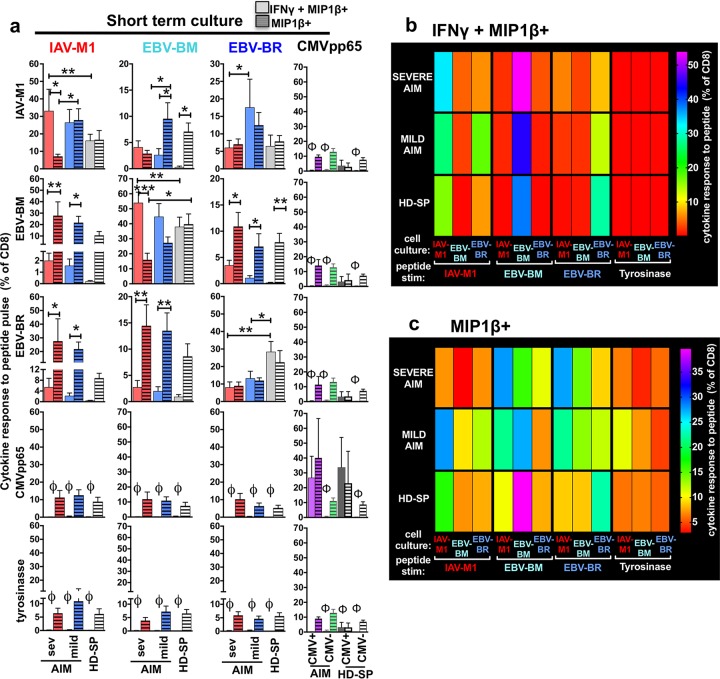FIG 7 .
Cells from the severe-AIM, mild-AIM, and HD-SP groups each maintain a unique cognate and cross-reactive CD8 T-cell cytokine profile upon peptide stimulation in short-term in vitro cultures. Summary analyses of the cytokine profiles of IAV-M1, EBV-BM, and EBV-BR peptide-stimulated short-term cultures of cells from severe (sev)- and mild-AIM patients and HD-SP show significant differences in their functional responses to cognate (same as the culture peptide) and cross-reactive peptides (5 to 10 donors per group). The cytokine production of IAV-M1-, EBV-BM-, and EBV-BR-specific cells in each culture was determined by stimulation with each of the peptides in an intracellular cytokine assay and determination of the frequency of either double-cytokine-producing (IFNγ + MIP1β+) cells (a and b) or MIP-1β-only-producing (MIP1β+) cells (a and c). (a) Greater expansion of functional IFN-γ+ cross-reactive responses in severe-AIM patients versus mild-AIM patients in IAV-M1- and EBV-BM-stimulated rather than EBV-BR-stimulated short-term cultures. There was a significantly higher frequency of cognate IAV-M1 or cognate EBV-BM IFN-γ versus MIP-1β-only-producing cells in severe-AIM patients than in mild-AIM patients or HD-SP. There was a significantly lower frequency of cognate EBV-BR IFN-γ+ cells in severe-AIM and mild-AIM patients than in HD-SP. In both patient groups, cross-reactive peptides induce significantly more MIP-1β than IFN-γ, except upon an IAV-M1 pulse of either EBV-BM or EBV-BR cultures from severe-AIM patients. Also, an IAV-M1 pulse of EBV-BR cultures resulted in greater IFN-γ production by mild-AIM patients than by severe-AIM patients. Control cultures included short-term cultures with CMV pp65 or tyrosinase peptide (not shown), where the frequencies of IFN-γ+ cells were ≤0.1%, as indicated by the symbol φ. *, P < 0.05; **, P < 0.01. (b) Each donor group has a unique profile of cognate and cross-reactive IAV/EBV-specific IFN-γ+ CD8 T cells, as demonstrated in a heat map display with multivariate analyses. A cognate EBV-BM peptide pulse induced the greatest frequency of IFN-γ+ cells in all donors groups. In severe- and mild-AIM patients, it was significantly higher than all other populations, including cognate EBV-BR and IAV-M1, while in HD-SP, there were equal frequencies of cognate EBV-BR IFN-γ+ cells. A cognate IAV-M1 pulse in all donor groups induced the next greatest frequency of IFN-γ+ cells. A cognate EBV-BR peptide pulse induced the greatest frequency of IFN-γ+ in HD-SP. However, in both severe- and mild-AIM patients, the cognate EBV-BR IFN-γ+ cell level was so low that it was not significantly different from that of any other condition, including tyrosinase peptide pulse controls, except that it was significantly less than cognates EBV-BM and IAV-M1 in severe AIM and only cognate EBV-BM in mild AIM. (c) Each donor group has a unique profile of cognate and cross-reactive IAV/EBV-specific MIP-1β+ CD8 T cells, as demonstrated in a heat map display with multivariate analyses. In severe-AIM patients, a cross-reactive EBV-BM and EBV-BR peptide pulse of IAV-M1 cultures induces the greatest frequency of MIP-1β+ cells, significantly greater than cognate IAV-M1 and greater than their counterparts in HD-SP. In mild-AIM patients, the cognate IAV-M1 and EBV-BM peptide pulse induced the greatest number of MIP-1β+ cells. In HD-SP, the cognate EBV-BM peptide pulse induced the greatest number of MIP-1β+ cells in comparison to all other conditions and significantly more than cognate EBV-BM in severe-AIM patients. The Student t test was used to compare two groups, one-way ANOVA with Sidak’s multiple-comparison test was used to compare more than two groups, and multivariate analyses were performed by two-way ANOVA with Tukey’s multiple-comparison test. *, P < 0.05; **, P < 0.01; ***, P < 0.001 (P values are adjusted for multiple comparisons). All of the multiple important significant and nonsignificant differences in these graphs are shown in Fig. S6 to highlight differences between the patient groups.

